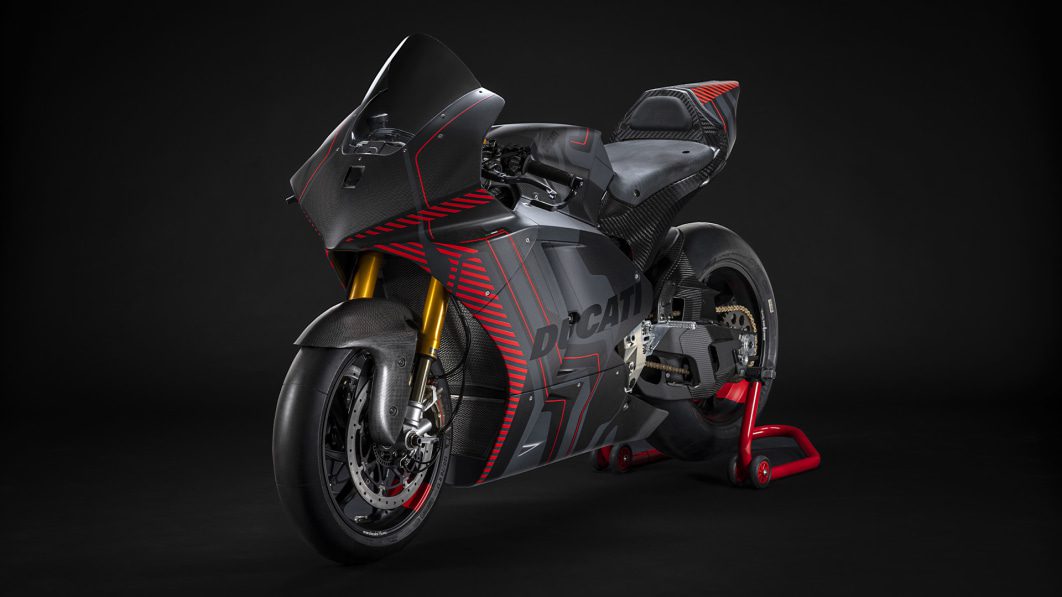Ducati MotoE prototype V21L bike almost ready for 2023

There are three global electric racing series’ sanctioned by global governing bodies: The FIA’s Formula E and Extreme E, and the FIM’s MotoE. Since the beginning of the MotoE series in 2019, Energica has been the sole supplier of the spec two-wheelers. From next year, Ducati becomes the sole supplier, and that means developing an electric bike worth the red label from Bologna. Enter the V21L, Ducati’s prototype battery-powered motorcycle for the track that will one day certainly lead to electric Ducatis for the road.
The manufacturer says it called on all departments to work together in a way not done before. Ducati R&D managed the project and oversaw the design and simulation work for the electric powertrain. Ducati Corse worked up the design of parts, software strategies, aero and dynamic simulations, assembly, and data acquisition. The goal with the V21L is to produce an electric ride that performs dynamically in the same way as the ICE-powered Desmosedici GP that Ducati runs in MotoGP. The engineers visited the ID department at parent company Volkswagen for suggestions on how to hit the targets. Ducati Stile drew up the bodywork and livery, ensuring the brand’s trademark looks despite the heart transplant.
Ducati chose to create a lighter bike with less power in exchange for better dynamic response. The V21L weighs 496 pounds all up, which is 26.5 pounds less than the minimum weight that the FIM and MotoE rights holder Dorna imposed on 2023 bikes, 77 pounds lighter than the Energica bikes now in use. The V21L makes the same horsepower as the Energica, but it’s 103 lb-ft are 59 torques down on the Energica’s 162 lb-ft.
That heart is a 242.5-pound battery composed of 1,152 cylindrical Type 21700 cells, the same variety Tesla uses. Set in a carbon fiber case and tilted back for optimum balance, the 18 kWh capacity can be refilled to 80% in 45 minutes through the tail-mounted 20-kW charging socket. An unnamed third party designed the 46.3-pound motor to Ducati specs, maximum output registering 148 horsepower and 103 pound-feet of torque. An 11-pound inverter and 800-volt electrical architecture ensure healthy communication between components. One cooling circuit manages battery temps, a second cooling circuit tends to the motor and inverter. The company says this keeps the battery constantly in its ideal charging range, so there’s no need to prep the pack or wait before plugging in.
The carbon fiber battery case sits in an aluminum subframe and there’s an aluminum rear swingarm. The rear subframe holding the seat and tail, and the bodywork, are carbon fiber. Öhlins provides the front and rear shocks and steering damper, Brembo supplies a robust braking system with extra thick, slotted dual discs in front to go with the single disc in back. Because there’s no gearbox, MotoE riders can choose to fit a rear brake lever ahead of the left grip instead of using a foot pedal.
The prototype electric bike weighs 150 pounds more than Ducati’s Desmosedici GP bike used in MotoGP. The best MotoE lap time around Mugello this year was 1:58.939, almost two seconds slower than a Moto3 bike that uses a 250-cc one-cylinder engine making a maximum 55 hp. The fastest lap during the MotoGP race was 1:46.588. We’ve been told the V21L can hit a top speed of 171 miles per hour, a slight edge over the Energica, but Ducati’s being coy with lap times for now. We suspect the Italians expect the lighter weight to boost cornering speeds and outdo the Energica.
Next year’s MotoE campaign will see 18 electric Ducatis on the starting grid. Some unknown amount of time after that, Ducati says the lessons from racing will allow it to “create, as soon as the technology will allow, a Ducati electric vehicle that is sporty, light, exciting and able to satisfy all enthusiasts.”
Related video:



